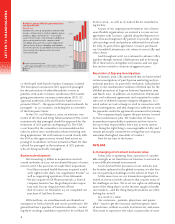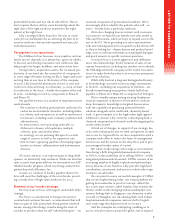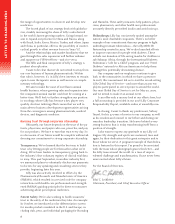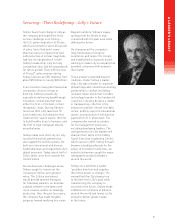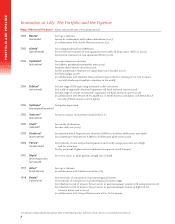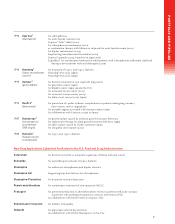Eli Lilly 2008 Annual Report Download - page 16
Download and view the complete annual report
Please find page 16 of the 2008 Eli Lilly annual report below. You can navigate through the pages in the report by either clicking on the pages listed below, or by using the keyword search tool below to find specific information within the annual report.
FINANCIALS
14
of tadalafi l. We received an upfront payment of $150.0
million in exchange for exclusive rights to commercial-
ize tadalafi l for PAH in the U.S., as well as for a product
manufacturing and supply arrangement. As part of this
arrangement, we acquired a $150.0 million equity posi-
tion in the company. The indication is currently under
review by the FDA.
•
We acquired the worldwide rights to the dairy cow
supplement Posilac®, as well as the product’s support-
ing operations, from Monsanto Company (Monsanto) for
an upfront payment of $300.0 million, as well as contin-
gent consideration based on future Posilac sales. The
acquisition of Posilac provides us with a product that
complements those of our animal health product line.
• We sold our Greenfi eld Laboratories site in Greenfi eld,
Indiana, to Covance Inc. We also signed a 10-year
service agreement, under which Covance will assume
responsibility for our toxicology testing and other R&D
support activities at the site.
• We acquired SGX for approximately $64 million in cash.
The acquisition allows us to integrate SGX’s structure-
guided drug discovery platform into our drug discovery
efforts. It also gives us access to FAST™, SGX’s frag-
ment-based, protein structure guided drug discovery
technology, and to a portfolio of preclinical oncology
compounds focused on a number of kinase targets.
• We entered into a licensing and development agree-
ment with TransPharma Medical Ltd. (TransPharma)
to acquire rights to its product and related drug
delivery system for the treatment of osteoporosis. The
product, which is administered transdermally using
TransPharma’s proprietary technology, is currently in
Phase II clinical testing.
• We entered into an agreement with an affi liate of TPG-
Axon Capital (TPG) for the Phase III development of our
two lead molecules for the treatment of Alzheimer’s
disease. This agreement provides TPG with success-
based milestones and royalties in exchange for clinical
trial funding.
•
We entered into a licensing and development agree-
ment with BioMS whereby we acquired exclusive world-
wide rights to a multiple sclerosis (MS) compound. The
compound is currently being evaluated in two pivotal
Phase III clinical trials in secondary progressive MS.
Legal, Regulatory, and Other Matters
In March 2004, we were notifi ed by the U.S. Attorney’s
offi ce for the EDPA that it had commenced an investi-
gation relating to our U.S. marketing and promotional
practices for Zyprexa, Prozac®, and Prozac Weekly™. In
October 2008, we announced that we were in advanced
discussions to resolve the ongoing investigations led
by the EDPA, and we recorded a charge of $1.42 billion.
In January 2009, we announced that the discussions
had been successfully concluded, and that we settled
the Zyprexa-related federal claims, as well as similar
Medicaid-related claims of states which decide to par-
ticipate in the settlement.
Beginning in August 2006, we received civil inves-
tigative demands or subpoenas from the attorneys
general of a number of states under various state con-
sumer protection laws seeking documents pertaining to
Zyprexa. In October 2008, we reached a settlement with
32 states and the District of Columbia, under which we
paid $62.0 million.
In December 2008, the Federal Supreme Court
(BGH) in Germany re-established our Zyprexa patent
that had been declared invalid in 2007 by the German
Federal Patent Court. As a result of this ruling, generic
olanzapine has been withdrawn from the German mar-
ket as of the beginning of 2009.
We continue to reach agreements with claimants’
attorneys involved in U.S. Zyprexa product liability liti-
gation to settle claims against us relating to the medi-
cation. Approximately 120 claims remain.
In the third quarter of 2008, we initiated a strate-
gic review of our Tippecanoe manufacturing facility in
Lafayette, Indiana. Options being considered for this
site include continuing operations with a revised site
mission, exploring opportunities to sell the facility, and
ceasing operations altogether. The review is expected to
last six to twelve months. No fi nal decisions have been
made at this time; however, depending on the decision,
we could record signifi cant charges.
In the United States, the Medicare Prescription
Drug, Improvement, and Modernization Act of 2003
(MMA) continues to provide an effective prescription
drug benefi t under the Medicare program (known as
Medicare Part D). Various measures have been dis-
cussed and/or passed in both the U.S. House of Repre-
sentatives and U.S. Senate that would impose additional
pricing pressures on our products, including propos-
als to legalize the importation of prescription drugs
and either allow, or require, the Secretary of Health
and Human Services to negotiate drug prices within
Medicare Part D directly with pharmaceutical manu-
facturers. Additionally, various proposals have been
introduced that would increase the rebates we pay on
sales to Medicaid patients or impose additional rebates
on sales to patients who receive their medicines through
Medicare Part D. Uncertainty exists surrounding the
new administration and Congress and the impact any
government decisions or programs will have on the
pharmaceutical industry. In addition, many states are
facing substantial budget diffi culties due to the down-
turn in the economy and are expected to seek aggres-
sive cuts or other offsets in healthcare spending. We
expect pricing pressures at the federal and state levels
to become more severe, which could have a material
adverse effect on our consolidated results of operations.
International operations also are generally subject
to extensive price and market regulations, and there


